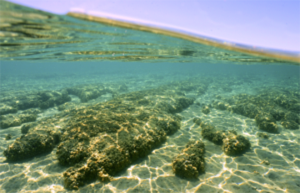
Stromatolites have been discovered beyond the well-researched south-east corner of Hamelin Pool, in Shark Bay Western Australia, according to a researcher from Bush Heritage.
Erica Suosaari donned a wetsuit and spent three years being dragged behind a boat to investigate the entire pool for the first time.
She found stromatolites around almost the entire 135km margin.
“Stromatolites are a big deal,” says Erica.
“They are remnants of the oldest known life form. These structures dominate the fossil record for more than 80 per cent of the Earth’s history. The microbes that built them produced the oxygen that made animal life possible on earth,” she says.
“They represent a huge leap in our understanding of the diversity of modern and ancient life at the site. They effectively offer us a window into early life on Earth.”
Hamelin Pool is a World Heritage Area based partly on the fact that it is home to the largest and most diverse modern assemblage of stromatolites on the planet.
Stromatolites are the remains of living mats of bacteria that trap and bind surrounding sediments or precipitated carbonate cements, leaving behind a rock fabric that causes the structure to grow vertically.
And the bacteria that formed those ancient structures are the reason we’re alive. Their busy photosynthesis for the first few billion years of Earth’s history produced the oxygen that made animal life possible.
They were first discovered in the 1950s but, until now, research on the ancient structures has been concentrated in the south-eastern region of the bay.
Erica was determined to look further and investigated the entire pool for the first time.
She discovered distinct ‘provinces,’ where each has a different and distinct assemblage of stromatolite forms – a result of depth gradient and local environmental pressures.
She estimates there are 100 million stromatolites at the site, including fossils similar to those that existed long before modern times.
Note: The above post is reprinted from materials provided by Fresh Science.










